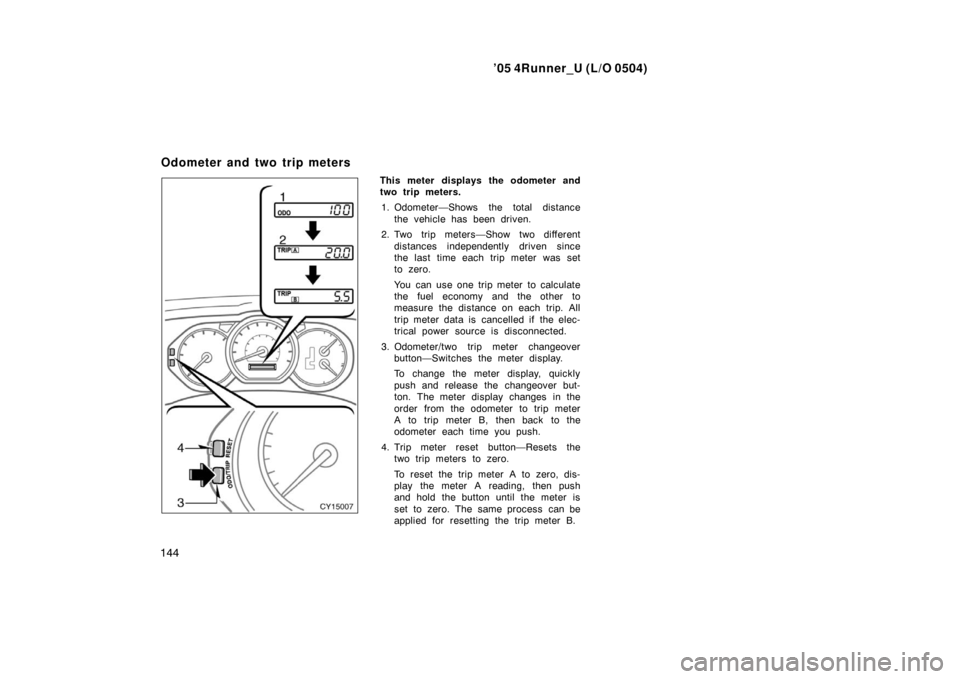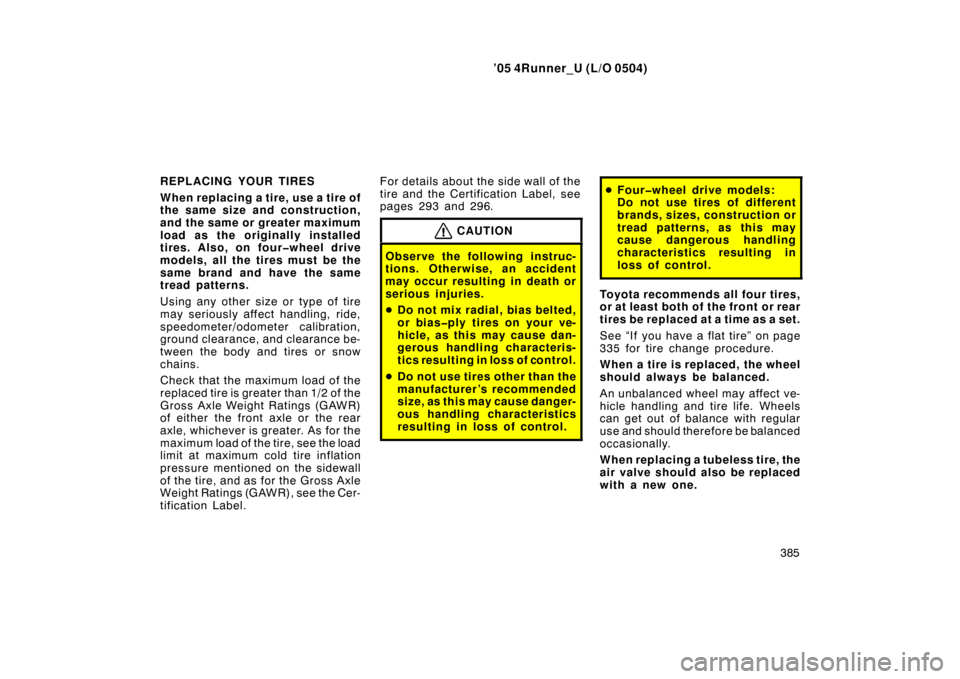Page 16 of 426
’05 4Runner_U (L/O 0504)
6
1. Trip meter reset button
2. Tachometer
3. Service reminder indicators and
indicator lights 4. Speedometer
5. Fuel gauge
6. Low fuel level warning light
7. Engine coolant temperature gauge
8. Odometer and two trip meters
9. Odometer/two trip meter changeover
button
Instrument cluster overview
Page 151 of 426
’05 4Runner_U (L/O 0504)
141
OPERATION OF INSTRUMENTS AND
CONTROLS
Gauges, Meters and Service reminder indicators
Fuel gauge 142
. . . . . . . . . . . . . . . . . . . . . . . . . . . . . . . . . . . . .\
. . . . . . . . . . .
Engine coolant temperature gauge 142
. . . . . . . . . . . . . . . . . . . . . . . . . . .
Tachometer 143
. . . . . . . . . . . . . . . . . . . . . . . . . . . . . . . . . . . . \
. . . . . . . . . . . .
Odometer and two trip meters 144
. . . . . . . . . . . . . . . . . . . . . . . . . . . . . . . .
Service reminder indicators and warning buzzers 145
. . . . . . . . . . . . . .
SECTION 1� 6
Page 154 of 426

’05 4Runner_U (L/O 0504)
144
This meter displays the odometer and
two trip meters.
1. Odometer—Shows the total distance the vehicle has been driven.
2. Two trip meters—Show two different distances independently driven since
the last time each trip meter was set
to zero.
You can use one trip meter to calculate
the fuel economy and the other to
measure the distance on each trip. All
trip meter data is cancelled if the elec-
trical power source is disconnected.
3. Odometer/two trip meter changeover button—Switches the meter display.
To change the meter display, quickly
push and release the changeover but-
ton. The meter display changes in the
order from the odometer to trip meter
A to trip meter B, then back to the
odometer each time you push.
4. Trip meter reset button—Resets the two trip meters to zero.
To reset the trip meter A to zero, dis-
play the meter A reading, then push
and hold the button until the meter is
set to zero. The same process can be
applied for resetting the trip meter B.
Odometer and two trip meters
Page 161 of 426

’05 4Runner_U (L/O 0504)
151
(h) Engine Oil Replacement Reminder
Light (for vehicles sold in U.S.A.)
This light acts as a reminder to replace
the engine oil.
This light will come on when the ignition
key is turned to “ON” and will go off after
about a few seconds.
When you drive for about 7200 km (4500
miles) after the engine oil replacement,
this light illuminates for about 3 seconds
and then flashes for about 12 seconds
with the ignition key turned to the “ON”
position. If you continue driving without
the engine oil replacement, and if the driv-
ing range exceeds 8000 km (5000 miles),
the light will come on after the ignition
key is turned to the “ON” position. The
light will remain on thereafter.
If the light is flashing, we recommend that
you replace the engine oil at an early
opportunity depending on the driving and
road condition. If the light comes on, re-
place it as soon as possible. You need to reset the light after the en-
gine oil replacement. Reset the light by
following the procedure below:
1. Turn the ignition key to the “ACC” or “LOCK” position with the odometer
reading shown. (For details, see
“Odometer and two trip meters” on
page 144 in this Section.)
2. Turn the ignition key to the “ON” posi- tion while holding down the trip meter
reset button.
Hold down the button until the light goes
off. Before the light goes off, it illuminates
for 3 seconds, flashes for 2 seconds and
illuminates for 1 second.
If the system fails to reset, the light will
remain flashing.
(i) “ABS” Warning Light
The light comes on when the ignition key
is turned to the “ON” position. If the anti −
lock brake system and the brake assist
system work properly, the light turns off
after a few seconds. Thereafter, if either
of the systems malfunctions, the light
comes on again. When the “ABS” warning light is on (and
the brake system warning light is off), the
following systems do not operate, but the
brake system still operates conventionally.
�Anti
−lock brake system
�Brake assist system
�Traction control system
(two −wheel drive models)
�Active traction control system
(four −wheel drive models)
�Vehicle stability control system
�“AUTO LSD” system
(two −wheel drive models)
�Downhill assist control system
(four −wheel drive models)
�Hill −start assist control system
When the “ABS” warning light is on (and
the brake system warning light is off), the
anti −lock brake system does not operate,
so that the wheels will lock up during a
sudden braking or braking on slippery
road surfaces.
Page 395 of 426

’05 4Runner_U (L/O 0504)
385
REPLACING YOUR TIRES
When replacing a tire, use a tire of
the same size and construction,
and the same or greater maximum
load as the originally installed
tires. Also, on four�wheel drive
models, all the tires must be the
same brand and have the same
tread patterns.
Using any other size or type of tire
may seriously affect handling, ride,
speedometer/odometer calibration,
ground clearance, and clearance be-
tween the body and tires or snow
chains.
Check that the maximum load of the
replaced tire is greater than 1/2 of the
Gross Axle Weight Ratings (GAWR)
of either the front axle or the rear
axle, whichever is greater. As for the
maximum load of the tire, see the load
limit at maximum cold tire inflation
pressure mentioned on the sidewall
of the tire, and as for the Gross Axle
Weight Ratings (GAWR), see the Cer-
tification Label.
For details about the side wall of the
tire and the Certification Label, see
pages 293 and 296.
CAUTION
Observe the following instruc-
tions. Otherwise, an accident
may occur resulting in death or
serious injuries.
�
Do not mix radial, bias belted,
or bias�ply tires on your ve-
hicle, as this may cause dan-
gerous handling characteris-
tics resulting in loss of control.
� Do not use tires other than the
manufacturer’s recommended
size, as this may cause danger-
ous handling characteristics
resulting in loss of control.
�Four�wheel drive models:
Do not use tires of different
brands, sizes, construction or
tread patterns, as this may
cause dangerous handling
characteristics resulting in
loss of control.
Toyota recommends all four tires,
or at least both of the front or rear
tires be replaced at a time as a set.
See “If you have a flat tire” on page
335 for tire change procedure.
When a tire is replaced, the wheel
should always be balanced.
An unbalanced wheel may affect ve-
hicle handling and tire life. Wheels
can get out of balance with regular
use and should therefore be balanced
occasionally.
When replacing a tubeless tire, the
air valve should also be repl aced
w i t h a new on e.